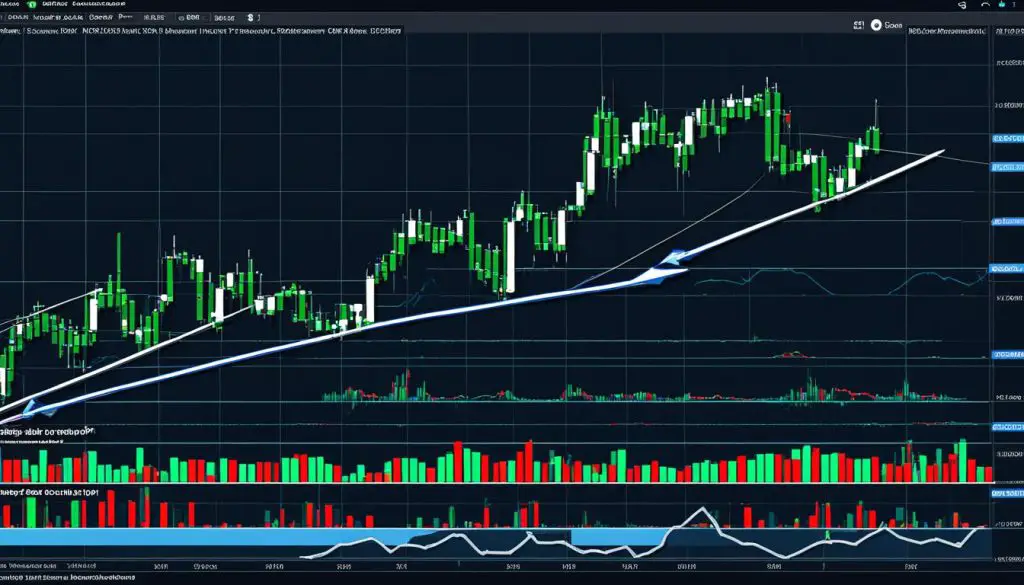As an adept forex trader, one must wield the ability to decipher complex market signals, relying heavily on sophisticated forex technical analysis to anticipate price changes. Among the plethora of patterns emerging within the bustling forex markets, tweezer tops forex patterns stand out as critical elements for heralding potential trend reversals. Seamlessly merging the wisdom of traditional Japanese candlestick charting with modern forex trading strategies, tweezer tops are instrumental in shifting the trajectory of trading decisions.
In the quest for proficiency and an upper hand in forex market analysis, understanding and leveraging forex reversal patterns like tweezer tops can be a game changer. Imbued with a rich history and potency in signaling pivotal price swings, the interpretation of these patterns propels traders towards making informed decisions, shrewdly navigating the volatile currency terrain. Thus, mastery of tweezer tops forex is more than a mere tactic—it’s an essential stratagem in the arsenal of any serious forex market participant.
Understanding Tweezer Tops in Forex Trading
Delving into the world of forex candlestick patterns, traders encounter a variety of strategies to forecast market moves. Among these, the tweezer tops pattern stands out as a reliable indicator for potential trend reversals. Developed centuries past but no less relevant in today’s markets, the forex trader must grasp the implications of such patterns for enduring success in currency trading. We now turn our attention toward the historical significance and the defining characteristics of tweezer tops and bottoms, followed by key insights for their identification within forex price action.
The Historical Roots of Candlestick Charting
Candlestick charting, a legacy from 17th-century Japanese commodity traders, continues to hold sway in the analysis of modern financial markets. The introduction of such a method to the Western traders’ toolbox could be attributed to the meticulous research and publication efforts by financial experts such as Steve Nison. This form of charting not only decorates the screens of traders worldwide but provides intricate details and insights into market sentiment and price action movements that are indispensable.
Characteristics of Tweezer Tops and Bottoms
Leading the brigade of reversal patterns, tweezer tops and bottoms are heralded for their simplicity and accuracy. A tweezer top formation, often leading to bearish reversals, comprises a pair of candlesticks that mark similar highs—the bearish tweezer tops characterized particularly by a subsequent smaller real body, hinting at waning buying pressure. Conversely, a tweezer bottom, which indicates bullish reversals, displays a matching set of lows—the bullish tweezer tops pattern depicting a potential upsurge in buyer enthusiasm.
Key Takeaways for Identifying Reversal Patterns
- Consider the forex price action leading to the tweezer structure; a genuine top is typically preceded by an uptrend, and a bottom follows a downtrend.
- Examine the real bodies and wicks of the candles to ascertain potential shifts—they should closely match in highs (tops) or lows (bottoms).
- Verify the rejection of higher prices (or lower in the case of tweezer bottoms) by the length and positioning of the candle’s wick.
- Look for complementary indicators, such as volume spikes or confirmatory patterns, to substantiate the anticipated reversal signaled by tweezer tops or bottoms.
Armed with historical knowledge, acute pattern recognition, and critical validation techniques, forex traders are well-equipped to navigate the ever-changing currents of the foreign exchange market.
Indicators of Market Reversals: The Role of Tweezer Tops
The intricate world of forex technical analysis hinges on the ability to decipher various chart patterns and signals to predict market movement. Among the myriad patterns, forex tweezer tops occupy a critical position as an indicator of potential forex reversal patterns. Recognizing a tweezer top formation is paramount for traders as it can signal the end of an uptrend and the possible beginning of a downtrend.
A tweezer top occurs during an uptrend when the highs of two candlesticks are positioned at approximately the same price level. This unique setup suggests that the buying pressure is starting to wane and the sellers may soon gain control, leading to a trend reversal. Spotting these formations early can deliver a competitive advantage to forex traders, allowing for timely adjustments to trade positions.
Effective utilization of tweezer tops for forecasting involves more than just recognizing the pattern. Traders often combine this signal with other aspects of technical analysis to reinforce their predictions. It is critical to note, however, that while tweezer tops can be a strong indicator of a reversal, confirmatory signals should ideally follow to validate the prediction.
| Candlestick Feature | Tweezer Tops Attributes | Relevance to Forex Reversal |
|---|---|---|
| First Candlestick | Bearish or Bullish | Indicates prevailing market sentiment |
| Second Candlestick | Opposite of the First or Small Real Body | Represents changing market dynamics |
| Highs of Candlesticks | Roughly Equal | Defines resistance level and potential price ceiling |
| Subsequent Price Action | Conformation via follow-up candles | Validates the tweezer tops as a reversal pattern |
In essence, being adept at forex technical analysis and understanding the nuances of tweezer tops empowers traders to discern between mere price fluctuations and significant forex reversal patterns, thus strategically informing trade decisions to harness potential market shifts.
Incorporating Tweezer Tops Forex into Technical Analysis
As investors dedicate time to crafting refined forex trading strategies, the importance of incorporating tweezer tops patterns into forex market analysis becomes increasingly evident. Recognizing these formations in tradingview is not just about spotting a classic pattern; it’s about integrating these signals into a comprehensive approach utilizing the various methods of forex technical analysis.
Combining Tweezer Tops with Other Technical Tools
Successful technical analysis hinges on the employment of multiple tools to validate any potential market signal. Tweezer tops forex discoveries serve as no exception. When these patterns materialize, it’s essential to seek confluence with additional indicators such as:
- Support and Resistance Levels: Significant price points where reversals or continuations might occur.
- Momentum Indicators: Such as the Relative Strength Index (RSI) or Moving Average Convergence Divergence (MACD), provide insight into the strength of the trend.
- Volume Measures: Confirming the participation level behind a potential reversal.
Assessing Momentum Shifts with Tweezer Tops
Understanding the subtleties of momentum is critical when evaluating tweezer tops within the forex market. The transition from an uptrend to the formation of a tweezer top often indicates a weakening of buyer power. Fusing this observation with momentum analysis can substantiate whether the shift signifies a formidable trend reversal or a temporary pause.
Criteria for Confirming Tweezer Tops Signals
To avoid false positives and enhance the reliability of tweezer tops in your forex technical analysis, apply the following criteria before executing trades:
- Positioning: Verify that tweezer tops occur after a substantial uptrend.
- Rejection: Look for price rejection near the highs of the tweezer top formation.
- Confirmation: Await additional candlestick patterns or indicator signals that corroborate the reversal.
Applying these techniques amplifies the accuracy of tweezer tops in predicting trend changes, thereby enhancing forex trading strategies for a variety of market conditions.
Effective Forex Trading Strategies Using Tweezer Tops
With a deep understanding of forex candlestick patterns, particularly the tweezer tops, traders have at their disposal a powerful tool for crafting superior forex trading strategies. These time-tested patterns are not only indicative of potential price action reversals but also provide structured entry and exit points within the volatile forex market. By incorporating the forex technical analysis insights offered by tweezer tops, traders can refine their approach to the markets, executing trades with greater precision and confidence.
Setting Up Trades: Entry and Exit Points
A critical component of leveraging tweezer tops within a forex trading strategy is to accurately establish entry and exit points. Tweezer tops, characterized by a pair of candlesticks with nearly identical high points, often signal an upcoming reversal in forex price action, especially after a sustained uptrend. Traders may consider entering a short position as the second candle of a tweezer top begins to diminish, with the expectation that a downtrend will follow.
Stop Loss Placement for Tweezer Top Patterns
Setting a stop loss is a vital risk management technique when trading tweezer tops. The placement of stop loss just above the tweezer top reduces potential losses should the market not move as anticipated. This strategic placement limits a trader’s exposure while allowing for enough market volatility. By adhering to this stop placement, traders can mitigate the impact of false signals that occasionally arise in forex candlestick patterns.
Capitalizing on Pullbacks in the Trend
Traders versed in forex technical analysis recognize tweezer tops as opportunities to capitalize on pullbacks. When these patterns occur within a broader uptrend, they may signify temporary weakness or consolidation. Sharp-eyed traders may use this indication to prepare for the continuation of the primary trend, utilizing the tweezer top signal to time their entries with the resurgence of bullish momentum.
| Pattern Feature | Trading Action | Outcome |
|---|---|---|
| Tweezer Top Formation | Consider short position | Potential trend reversal point |
| Two Candlesticks with Similar Highs | Identify optimum entry point | Improved precision in market entry |
| Stop Loss Above Tweezer Top | Limit potential losses | Enhanced trade risk management |
Conclusion
In the intricate landscape of the forex market analysis, the tweezer tops and bottoms provide indispensable cues for discerning shifts in market momentum. These candlestick patterns offer pivotal insight into potential trend reversals, thereby becoming a cornerstone for traders employing various forex trading strategies. Although tweezer formations alert traders about possible changes in price direction, it is crucial to corroborate these patterns with subsequent candlestick activity to bolster the validity of the signal.
Effective forex technical analysis is not about isolated patterns; it involves a mosaic of indicators and market behavior interpretations. Both novice and seasoned traders can leverage tweezer tops within a comprehensive technical framework to refine their decision-making process. Thus, recognizing tweezer patterns is not the end-all of trade setups—it’s the critical starting point that seeks further confirmation from a trader’s arsenal of analytical tools.
Ultimately, the integration of tweezer tops and bottoms into a trader’s strategy can enhance the decision-making prowess, fortifying the potential for fruitful forex trading outcomes. By marrying technical analysis with market experience, traders are better equipped to navigate the tides of currency exchanges, making informed and strategic maneuvers when tweezer patterns come into play.
FAQ
A tweezer tops forex pattern is a bearish reversal signal consisting of two consecutive candlesticks with almost identical highs. This pattern usually appears after an upward price movement and signifies a potential shift in market trend.
The tweezer tops are identified by two adjacent candlesticks that have similar or equal highs. The first candlestick typically has a large real body, indicating a strong push upward, while the second candle can vary in size and signals a halt or decline in buyer momentum.
While tweezer tops can be a helpful indicator of trend reversals, they should not be used in isolation. For higher accuracy, these patterns should be confirmed with other technical analysis tools such as indicators of support and resistance, momentum indicators, or volume analysis.
Bullish tweezer patterns, or “tweezer bottoms,” are formed at the end of a downtrend and feature two consecutive candlesticks with almost identical lows. Bearish tweezer patterns, or “tweezer tops,” occur after an uptrend and have two candlesticks with nearly the same highs, indicating a potential reversal to a downtrend.
To set up trades using tweezer tops, traders should look for these patterns at the end of an uptrend. Once a pattern is identified, a trader may take a short position with an entry point below the low of the second candlestick. It is crucial to incorporate other market analysis techniques to confirm the reversal signal.
Stop loss orders when trading tweezer tops should be placed just above the pattern’s high. This allows traders to mitigate potential losses if the price action does not proceed as expected and the trend reversal does not materialize.






